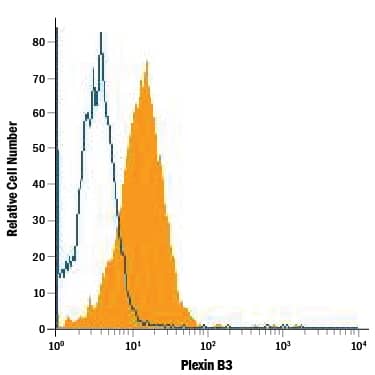Human Plexin B3 Antibody
R&D Systems, part of Bio-Techne | Catalog # MAB4958


Key Product Details
Species Reactivity
Validated:
Cited:
Applications
Validated:
Cited:
Label
Antibody Source
Product Specifications
Immunogen
His45-Gln1255
Accession # Q9ULL4
Specificity
Clonality
Host
Isotype
Scientific Data Images for Human Plexin B3 Antibody
Detection of Plexin B3 in A172 Human Cell Line by Flow Cytometry.
A172 human glioblastoma cell line was stained with Mouse Anti-Human Plexin B3 Monoclonal Antibody (Catalog # MAB4958, filled histogram) or isotype control antibody (Catalog # MAB002, open histogram), followed by Phycoerythrin-conjugated Anti-Mouse IgG Secondary Antibody (Catalog # F0102B).Applications for Human Plexin B3 Antibody
CyTOF-ready
Flow Cytometry
Sample: A172 human glioblastoma cell line
Formulation, Preparation, and Storage
Purification
Reconstitution
Formulation
Shipping
Stability & Storage
- 12 months from date of receipt, -20 to -70 °C as supplied.
- 1 month, 2 to 8 °C under sterile conditions after reconstitution.
- 6 months, -20 to -70 °C under sterile conditions after reconstitution.
Background: Plexin B3
Plexin B3 is a type I transmembrane glycoprotein that belongs to the Plexin B subfamily of semaphorin receptors (1, 2). Human Plexin B3 contains a 44 amino acid (aa) signal sequence, a 1211 aa extracellular domain (ECD), a 21 aa transmembrane domain, and a 633 aa cytoplasmic domain that includes features common to other Plexins, such as an LRR (C1) and LRF (C2) domain, and a PDZ motif common to B Plexins (1). The PDZ motif is thought to be involved in RhoA activation and axonal growth cone collapse downstream of semaphorin engagement (3). The human Plexin B3 ECD shares 81%, 81%, 83% and 75% aa identity with mouse, rat, bovine and canine Plexin B3, respectively. It contains a sema domain and a Plexin-Semaphorin-Integrin (PSI) or Met-Related Sequence (MRS) domain, each of which contains a potential proteolytic cleavage site (2). Detection of 160 and 140 kDa species along with the full-length 260 kDa Plexin B3 in homogenates of human neocortex indicates that proteolytic processing may occur in vivo (2). The ECD also contains four glycine/proline-rich IPT/TIG domains, which are immunoglobulin-like domains found in Plexins, transcription factors, and the scatter factor receptors Met and Ron. B Plexins, including Plexin B3, can interact with Met and Ron, activating these receptors upon semaphorin engagement (4, 5). Plexin B3 and its identified ligand, the transmembrane semaphorin Sema5A, are both expressed during differentiation and migration of central nervous system oligodendrocytes (5‑7). However, the developmental functions of Sema5A are likely independent of Plexin B3, which is not significantly expressed prenatally (8). In turn, Plexin B3 may exhibit Sema5A-independent activity, as homophilic interactions of sema domains are reported to stimulate neurite outgrowth of postnatal cerebellar neurons (2).
References
- Negishi, M. et al. (2005) Cell. Mol. Life Sci. 62:1363.
- Hartwig, C. et al. (2005) BMC Neurosci. 6:53.
- Swiercz, J.M. et al. (2002) Neuron 35:51.
- Conrotto, P. et al. (2004) Oncogene 23:5131.
- Artigiani, S. et al. (2004) EMBO Rep. 5:710.
- Goldberg, J.L. et al. (2004) J. Neurosci. 24:4989.
- Worzfeld, T. et al. (2004) Eur. J. Neurosci. 19:2622.
- Fiore, R. et al. (2005) Mol. Cell. Biol. 25:2310.
Alternate Names
Gene Symbol
UniProt
Additional Plexin B3 Products
Product Documents for Human Plexin B3 Antibody
Product Specific Notices for Human Plexin B3 Antibody
For research use only